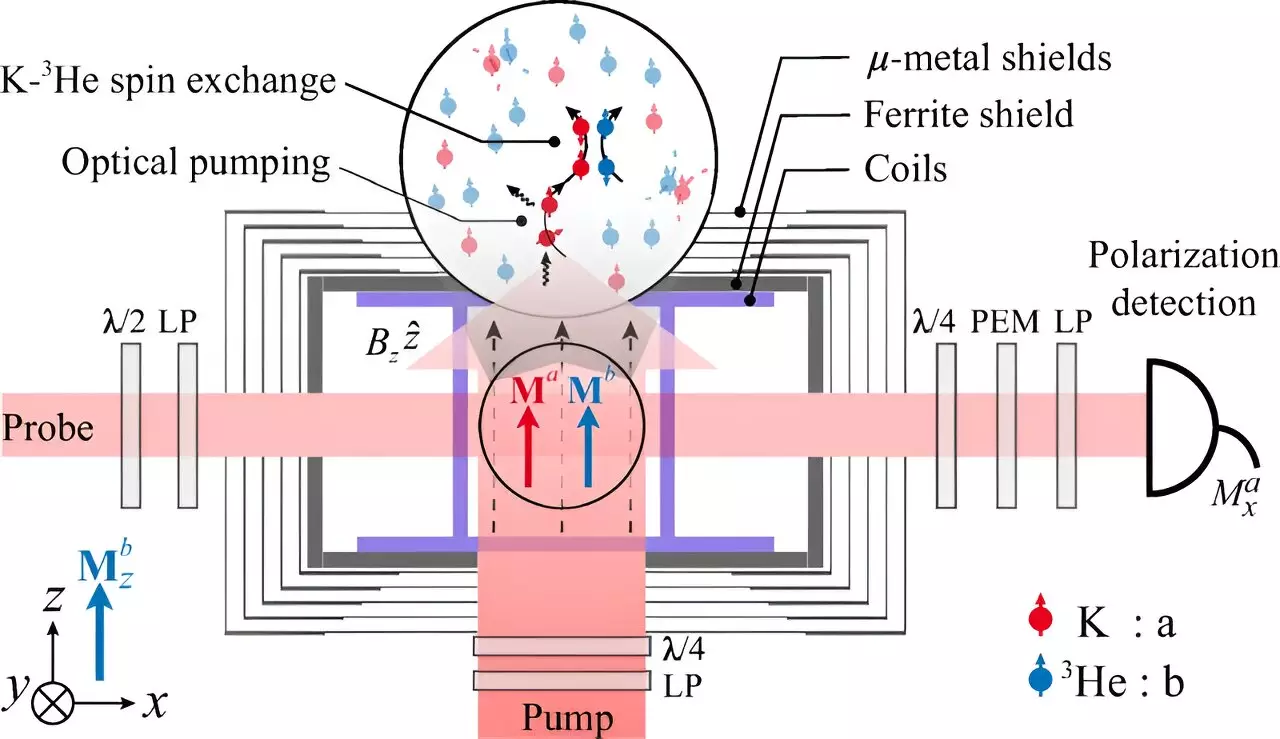In contemporary physics, the pursuit of precision measurement has increasingly illuminated the complex interactions between atomic spins and their implications in various fields. Particularly noteworthy is the recent revelation of a Fano resonance interference effect within mixed atomic spins, as explored by a research team spearheaded by Prof. Peng Xinhua and Associate Prof. Jiang Min from the University of Science and Technology of China (USTC). Their findings, published in *Physical Review Letters*, introduce an innovative magnetic noise suppression technique that significantly minimizes interference from magnetic noise, achieving noise reduction of at least two orders of magnitude. This research stands at the cutting edge of physics, focusing on exotic spin interactions that extend beyond classical paradigms.
Exotic spin interactions are currently a hot topic in precision measurement. These interactions involve phenomena such as the investigation of spin-dark matter particle interactions and even propositions regarding a fifth fundamental force. Within this framework, the measurement of extremely weak magnetic fields becomes paramount. However, these weak signals are often buried beneath layers of noise, complicating experimental efforts. The traditional mitigation strategies, such as atomic comagnetometers, have addressed some of these challenges but have primarily proved effective only against low-frequency magnetic noise, limiting their utility for a wide array of quantum experiments.
The USTC researchers tackled this issue head-on by developing a magnetic noise suppression technique leveraging the self-compensation effects of magnetic noise. This concept was experimentally validated in a mixed system comprising potassium (K) and 3He gases. Here, K, when polarized with laser techniques, served not only as a populace for magnetic detection but also facilitated nuclear spin polarization in 3He through spin-exchange collisions. This innovative dual-spin approach permitted the detection systems to counteract magnetic field fluctuations more effectively.
In old methodologies, the magnetic bias fields used were set to balance each other out, following an equal but opposing vector. However, this approach proved limited under certain operational conditions. The new study elucidates that varying the bias field magnitude and adjusting the detection angle relative to the external noise frequency leads to a significant suppression of higher-frequency magnetic noise. This nuanced understanding opens new avenues for experimentation that were previously thought infeasible.
The researchers further provide a robust theoretical framework to contextualize these findings, detailing how Fabry-Perot resonance interference cancellation can qualitatively interpret the experimental results. This theoretical backing not only strengthens the credibility of the findings but also enhances their potential applicability across various domains. Notably, the method successfully suppressed magnetic noise from near direct current frequencies up to 200Hz, a range previously unmanageable with current technology.
Moreover, the implications of this newfound capability are substantial. If combined with existing magnetic detection technologies, exploiting this self-compensation effect could potentially astronomically enhance sensitivity levels to pseudomagnetic fields, reaching up to 0.1 fT/Hz^(1/2) across a more extensive frequency spectrum. Such advancements may revolutionize fields concerned with dark matter detection and the exploration of exotic spin interactions—significantly contributing to fundamental physics research.
The exploration into magnetic noise suppression and exotic spin interactions is not just an academic endeavor; it represents a quest to unlock new theories and understandings about the universe itself. As researchers like those from USTC delve deeper into the complexities of atomic spins and their interactions, each discovery propels the field further into uncharted waters.
The versatility of these techniques can potentially lead to breakthrough advancements in other scientific domains such as cosmology, materials science, and quantum technologies. Hence, the continued exploration of the intersection between atomic physics and innovative measurement strategies may yield transformative insights that could redefine our understanding of matter and energy in the cosmos.
The resilience of the human spirit in pioneering scientific innovation continues to inspire, reminding us that with each breakthrough—in this case, the remarkable technique for magnetic noise suppression—new questions arise, opening the doors to further inquiry and deeper understanding. The future indeed looks promising as we venture into the great unknown of fundamental physics.


Leave a Reply